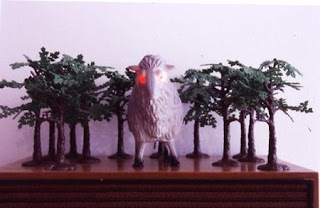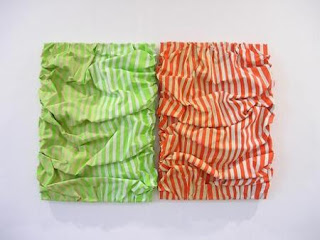







Mr and Mrs Pinks' was an HSP group show that toured to the Blue Oyster gallery in Dunedin. It was then shown at HSP. A loud, noisy show, it played host to 26 artists working in painting, sculpture, video and audio. There are snazzy HSP fundraiser t-shirts if only the pinks could get there hands on this . There is also an HSP catalogue somewhere which is probably the best to be able to view this show posthumously.
Collecting with the Pinks - Kate Montgomery.
It’s nothing new to see a privately assembled collection exhibited publicly. It’s nothing new to have a work or a series of works’ ownership details widely known. So what’s new about this exhibition? Well, for a start its “fabulous”, and not merely in the colloquial sense of the word. Yeah sure, it’s “good work”, but as a whole this exhibition boasts more, and has more to offer because of that. This exhibition does not presume to be a respectfully authentic show of the twin set and pearls variety, and apart from showcasing some of the most exciting work to emerge from Christchurch’s art scene in recent times, it challenges you to assess how it is that you view these “collected” works. Do you share the Pink’s penchant? Are you of their ilk? You knew you were coming to see new work by contemporary artists and this is the cutting edge.
James Clifford believes most forms of identity, whether cultural or personal, to presuppose and consequently depend upon various ‘acts of collection’. This principle can be seen as self-evident in many of the obsessions we permit ourselves to entertain and the collections or associations we assemble for ourselves over the course of a lifetime. Be it a personal library, rare natural “specimens” or a pile of vintage trainers, curios and collectables of all kinds inhabit our world and it is precisely the point to exercise control over that which interests us as we attempt to gather things together tastefully and appropriately. The assertion of a definitive or “personal” perspective is basically a blend of specific tastes and preferential appropriative and consumptive practices that also serve to signify investment and project a personalised sense of style. In relation to the “art world”, a sphere of specific and conspicuous production and consumption, it would seem that the public exhibition of private collections is a particularly interesting illustration of the various economies of exchange that go on within this cultural field.
The scenario is that private individuals loan their collected assets to a chosen institution for a fixed term (or in perpetuity) with the assurance (specified or not) of receiving kudos in relation to the sheer amount of cultural or economic capital invested within their now publicly recognised collection. Through the simple process of transferring private practices to a public forum, what was once a personal obsession or fetish is able to be held up for all to admire, and what had begun as a somewhat of fixation can be legitimised and envied by all. Without a doubt, one of the most remarkable collections of contemporary New Zealand art is that which has been amassed by the avid collectors Jim and Mary Barr. Interestingly, this pair would prefer to believe that their critical practices and collecting imperatives have had more of a disruptive and catalytic effect within the field of cultural collection and display than any “traditional” model of patronage would normally allow.
In what could be viewed as a particularly “Aotearoan” mode, Jim Barr has expressed the desire to ‘see exhibitions that turn things on their heads’ in a playful and disruptive manner that serves to make a space for creation and the dissemination of new perspectives and gestures . According to Jim, ‘collections should be argumentative not definitive’ and their collection seems to be getting bigger and bolder as these tastemakers continue to focus on the work of younger “often neglected” artists. The philosophy at the heart of the Barr’s project is that art patrons and institutions should tussle with what’s going on within the wider culture, ‘instead of presuming to package the culture… [they] should be constantly trying to describe it’ . And when you’re trying to get a point across, what’s wrong with a little role playing? Performative practices often help to illustrate a point most clearly, and a tongue-in-cheek approach often doesn’t go amiss either. Check out Michael Parekowhai’s Thief in the Barr’s loan collection to the Dunedin Public Art Gallery if you want to see what I mean. So “what’s the story” here then? Who exactly are these particularly savvy, risqué investors named Mr & Mrs Pink?
If a private collection is indicative of anything, surely it is illustrative of the taste and status of its owners. So how should we read this collection and who exactly are we dealing with here? Most obviously, this exhibition is an assertion of Christchurch’s culture of the contemporary arts. But what do these works tell us about their ‘owners’? Are we dealing with Mr & Mrs Elite/Bourgeois Pink? It might seem more likely that Mr & Mrs “I don’t brag I mostly pose” New Money Pink are responsible for this exciting and extensive collection. As such, the Pinks can be seen to have quietly yet conspicuously drawn fashionable attention in a manner like that of costume jewellery or the attention grabbing impact of fluro colours. This effect is that of an “attraction based on empty lust,” and this scene into which you yourself have been drawn is a charade in more ways than one.
I hope you didn’t take things too seriously. This is Mr & Mrs Pink’s Fabulous Collection after all; fabulous in the sense of “incredible” and “exaggerated” if you get my drift. One definition even lists “unhistorical” as a potential meaning of the word. But that shouldn’t really surprise, I mean good work is rarely ever pure truth or fiction. Most often it is a blend of both that produces the most subtle and thought provoking effects. Marcel Broodthaers harnessed and exploited this principle to great effect during the course of his institutionalisation of his fictional Musee d’Art Moderne’s Department of Eagles. According to Broodthaers ‘Fiction allows us to grasp reality and at the same time that which is veiled by reality’ . Thus, the fraudulent presence/absence of Mr & Mrs Pink is a rouse that allows us the freedom to question the value and potential agendas of those who are considered to be the “real” patrons and collectors of the arts.
Roland Barthes explains that ‘myth does not deny things… its function is to talk about them’ and in this case, the mythical presence of Mr & Mrs Pink could be seen to function in a number of ways. If their existence remains unquestioned, then visitors to the gallery may simply respond to this show based on their reading of the Pinks’ “tasteful” collection of works. Thus, the myth could serve to facilitate the interpretation of the works as a whole. Yet, when it becomes apparent that the Pinks are indeed a work of fiction themselves, then these counterfeit collectors can be seen to draw attention to the often unquestioned ideology of selection that occurs within group exhibitions such as this. Ultimately though, the introduction of Mr & Mrs Pink is inessential to the facilitation and merits of this exhibition. Realistically, they serve as a rouse that is not only inessential but almost incidental to this show’s realisation. This fiction was not designed or implemented as a well conceived strategy but rather is simply a tactic or experiment. It is therefore more of a ‘myth suited to a convenience, not to a necessity’ . Mr & Mrs Pink’s Fabulous Collection can therefore be understood as somewhat of a costume drama, an exposed and thus ‘barren’ myth that ‘by its very being labels itself as a myth and points to its masks’ . As such this exhibition does not intend to hoodwink its audience. Even though The Pink’s dubious façade may remain somehow mildly offensive, producing a vague sense of mistrust between the show’s audience and its curators/creators. (One can’t help but wonder about the acquisition of such a collection via dodgy backroom dealings in pink slips and secret handshakes).
This tactic then, and the challenge that alternative galleries such as The High Street Project and The Blue Oyster Gallery exemplify, is more of an immanent disruption or re-direction of attention than an exterior assault on the dominant relations that continue to exist within the cultural field of the contemporary arts. Mr & Mrs Pink’s Fabulous Collection can therefore be seen to draw attention to the structural assumptions of the situation not necessarily to provoke change, but rather to join in and revel in the soiree that is the fashionable culture of the contemporary arts.
1) Taken from “On collecting art and culture” in The Predicament of Culture. 2)Taken from an interview with Jim and Mary Barr published in Art New Zealand 65, pp.44-48,79. 3) By this I’m referring to the creation myth in which Tane Mahuta separates Rangi and Papa by inverting himself and forcing his parents apart, thus creating the space that we inhabit between earth and sky. 4)Jim Barr,p.48. 5) Mary Barr,p.45. 6)Rob McKenzie from Natural Selection,Issue 1:18.2. 7) Cited by James Putnam in his introduction to Art and Artifact: Museum as Medium. 8) From Mythologies,p.156. 9) Barthes, p.161.
10)Barthes, p.162.


